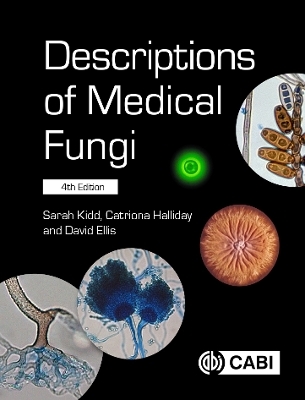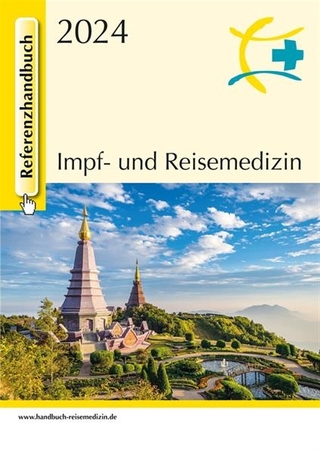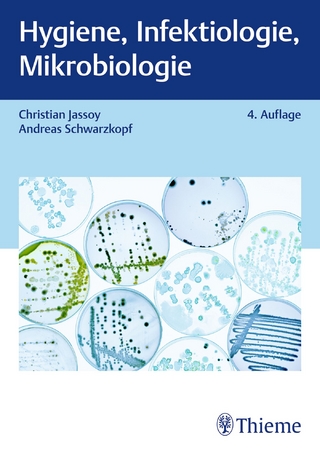
Descriptions of Medical Fungi
CABI Publishing (Verlag)
978-1-80062-232-6 (ISBN)
The 4th edition of this book provides laboratory staff and clinicians with a quick benchtop reference on the identification and antifungal susceptibility of human and animal fungal infections. It contains descriptions of all the major medical fungal pathogens, 179 species from 109 genera. This updated edition includes new and revised descriptions and he authors have reconciled current morphological descriptions and name changes with more recent genetic data. The most common fungal species are described, including members of the yeasts, mucoromycetes, conidial moulds, dimorphic pathogens, and dermatophytes. The book features: updates to taxonomy and fungal names. more than 350 colour photographs. antifungal susceptibility profiles, including for new drugs where available. methods of identification including molecular and/or MALDI-ToF mass spectroscopy. This handy reference is essential for laboratory staff and clinicians dealing with the identification and management of human and animal fungal infections, researchers in medical microbiology and mycology laboratories.
David Ellis (Author) David Ellis an Affiliate Associate Professor in the School of Biological Sciences, University of Adelaide, and Emeritus Mycologist at SA Pathology in Adelaide, Australia. He graduated from La Trobe University Botany Department with BSc Hons, MSc and PhD in mycology, and served as head of the Medical Mycology Unit at the Women's and Children's Hospital, for 33 years. David is a Fellow and Past President of the Australian Society for Microbiology and a recipient of the David White Teaching Award and the Lyn Gilbert Award that recognises major contributions in diagnostic laboratory microbiology in Australia. He is an Honorary Fellow of the Royal College of Pathologists of Australasia and a recipient of the RCPA Outstanding Teaching Award. David is an Honorary Member and Past General Secretary and President of the International Society for Human and Animal Mycology and a recipient of the ISHAM Lucille K Georg medal for distinguished contributions to medical mycology. He is also an Honorary Life Member of the Australasian Society for Infectious Diseases. David is a recipient of the Australasian College of Tropical Medicine Ashdown Medal and an Associate Member of the Australasian College of Dermatologists. He has been an author of 134 peer reviewed scientific papers and of 14 books and/or book chapters. Catriona Halliday (Author) Catriona Halliday is the Principal Scientist in charge of the Clinical Mycology Reference Laboratory, at the Institute for Clinical Pathology and Medical Research (ICPMR), NSW Health Pathology based at Westmead Hospital in Sydney. The laboratory has partnerships with Centre for Infectious Disease - Public Health (CIDM-PH) and the Sydney Institute for Infectious Diseases at the University of Sydney. Catriona is actively involved in teaching both scientific and medical staff in medical mycology and her research interests have focused on the development and implementation of culture independent tests to aid in the rapid diagnosis of invasive fungal infections, in particular invasive aspergillosis. More recent research projects have involved the evaluation of antifungal susceptibilities of novel antifungal drugs and the use of whole genome sequencing to detect antifungal resistance. She is head of the Laboratory Working Group of the Australian and New Zealand Mycoses Interest Group (ANZMIG), and a founding member of the ISHAM working group for Fungal PCR (FPCRI) working with international colleagues to develop recommendations to optimise PCR testing in fungal diagnostics. Most recently, Catriona is a member of the multi-disciplinary team of researchers who were awarded funding from WHO to develop the Fungal Priority Pathogen List and describe the R&D antifungal and diagnostic pipeline. Sarah Kidd (Author) Sarah Kidd is Head of the National Mycology Reference Centre at SA Pathology, as well as Adjunct Senior Lecturer at the University of Adelaide. She completed a Bachelor of Medical Science with Honours (1999) and a PhD in Medicine (2003), both at the University of Sydney. She has undertaken postdoctoral training and research in medical mycology at the University of British Columbia, Vancouver, Canada, and at Monash University at The Alfred Hospital, Melbourne. She is a Fellow of the Australian Society for Microbiology (ASM), and an active member of the Australasian Society of Infectious Diseases (ASID), and the International Society for Human and Animal Mycoses (ISHAM). Sarah has served as Secretary of the Australia and New Zealand Mycoses Interest Group (ANZMIG) since 2011 and has co-authored more than 80 peer reviewed journal articles and book chapters in the field of medical mycology. Sarah is active in mycology education in Australasia, has convened the biennial Mycology Masterclass since 2011, Co-Chaired the ISHAM 2015 Congress, and provides mycology expertise to the RCPA QAP Microbiology Advisory Committee and Mycology program.
1.: Acremonium 2.: Acrophialophora fusispora 3.: Alternaria 4.: Aphanoascus fulvescens 5.: Apiotrichum 6.: Apophysomyces complex 7.: Arthroderma 8.: Arthrographis kalrae 9.: Aspergillus 10.: Aureobasidium pullulans 11.: Basidiobolus ranarum 12.: Beauveria bassiana 13.: Bipolaris 14.: Blastomyces 15.: Candida 16.: Chaetomium 17.: Chrysosporium 18.: Cladophialophora 19.: Cladosporium 20.: Clavispora lusitaniae (syn. Candida lusitaniae) 21.: Coccidioides immitis/posadasii 22.: Colletotrichum coccodes 23.: Conidiobolus coronatus 24.: Coniochaeta hoffmannii (syn. Lecythophora hoffmannii; Phialophora hoffmannii) 25.: Cryptococcus 26.: Cunninghamella bertholletiae 27.: Curvularia 28.: Cutaneotrichosporon 29.: Cyberlindnera fabianii (syn. Candida fabianii) 30.: Cylindrocarpon 31.: Debaryomyces hansenii (syn. Candida famata) 32.: Diutina 33.: Drechslera 34.: Emergomyces 35.: Epicoccum nigrum 36.: Epidermophyton floccosum 37.: Exophiala 38.: Exserohilum 39.: Fonsecaea complex 40.: Fusarium 41.: Geotrichum candidum Link 42.: Gliocladium 43.: Graphium 44.: Histoplasma capsulatum complex 45.: Hortaea werneckii 46.: Kluyveromyces marxianus (syn. Candida kefyr; Candida pseudotropicalis) 47.: Lasiodiplodia theobromae (syn. Botryodiplodia theobromae) 48.: Lichtheimia corymbifera (syn. Mycocladus corymbifera; Absidia corymbifera) 49.: Lodderomyces elongisporus 50.: Lomentospora prolificans (syn. Scedosporium prolificans) 51. Lophophyton gallinae (syn. Microsporum gallinae): 10.1079/9781800622340.0051 52. Madurella complex: 10.1079/9781800622340.0052 53. Magnusiomyces: 10.1079/9781800622340.0053 54. Malassezia: 10.1079/9781800622340.0054 55. Malbranchea pulchella: 10.1079/9781800622340.0055 56. Marquandomyces marquandii (syn. Paecilomyces marquandii): 10.1079/9781800622340.0056 57. Meyerozyma guilliermondii (syn. Candida guilliermondii): 10.1079/9781800622340.0057 58. Microsphaeropsis arundinis: 10.1079/9781800622340.0058 59. Microsporum: 10.1079/9781800622340.0059 60. Mortierella wolfii: 10.1079/9781800622340.0060 61. Mucor: 10.1079/9781800622340.0061 62. Myrmecridium schulzeri (syn. Ramichloridium schulzeri): 10.1079/9781800622340.0062 63. Naganishia albida (syn. Cryptococcus albidus): 10.1079/9781800622340.0063 64. Nannizzia: 10.1079/9781800622340.0064 65. Neoscytalidium dimidiatum (syn. Hendersonula toruloidea): 10.1079/9781800622340.0065 66. Ochroconis: 10.1079/9781800622340.0066 67. Onychocola canadensis: 10.1079/9781800622340.0067 68. Paecilomyces variotii: 10.1079/9781800622340.0068 69. Papiliotrema laurentii (syn. Cryptococcus laurentii): 10.1079/9781800622340.0069 70. Paracoccidioides brasiliensis: 10.1079/9781800622340.0070 71. Paraphyton cookei (syn. Microsporum cookei): 10.1079/9781800622340.0071 72. Penicillium: 10.1079/9781800622340.0072 73. Phaeoacremonium parasiticum (syn. Phialophora parasiticum): 10.1079/9781800622340.0073 74. Phialophora verrucosa: 10.1079/9781800622340.0074 75. Phoma: 10.1079/9781800622340.0075 76. Pichia: 10.1079/9781800622340.0076 77. Pleurostoma richardsiae (syn. Pleurostomophora richardsiae; Phialophora richardsiae): 10.1079/9781800622340.0077 78. Pneumocystis jirovecii: 10.1079/9781800622340.0078 79. Prototheca: 10.1079/9781800622340.0079 80. Pseudopithomyces chartarum (syn. Pithomyces chartarum): 10.1079/9781800622340.0080 81. Purpureocillium lilacinum (syn. Paecilomyces lilacinus): 10.1079/9781800622340.0081 82. Quambalaria cyanescens (syn. Sporothrix cyanescens): 10.1079/9781800622340.0082 83. Rhinocladiella: 10.1079/9781800622340.0083 84. Rhizomucor: 10.1079/9781800622340.0084 85. Rhizopus: 10.1079/9781800622340.0085 86. Rhodotorula: 10.1079/9781800622340.0086 87. Saccharomyces cerevisiae: 10.1079/9781800622340.0087 88. Saksenaea vasiformis complex: 10.1079/9781800622340.0088 89. Sarocladium: 10.1079/9781800622340.0089 90. Scedosporium: 10.1079/9781800622340.0090 91. Schizophyllum commune: 10.1079/9781800622340.0091 92. Scopulariopsis: 10.1079/9781800622340.0092 93. Sepedonium: 10.1079/9781800622340.0093 94. Sporothrix schenckii complex: 10.1079/9781800622340.0094 95. Stemphylium: 10.1079/9781800622340.0095 96. Syncephalastrum racemosum: 10.1079/9781800622340.0096 97. Talaromyces marneffei (syn. Penicillium marneffei): 10.1079/9781800622340.0097 98. Torulaspora delbrueckii (syn. Candida colliculosa): 10.1079/9781800622340.0098 99. Trematosphaeria grisea (syn. Madurella grisea): 10.1079/9781800622340.0099 100.: Trichoderma 101.: Trichophyton 102.: Trichosporon 103.: Trichothecium roseum 104.: Ulocladium 105.: Veronaea botryosa 106.: Verruconis gallopava (syn. Ochroconis gallopava) 107.: Verticillium 108.: Wickerhamomyces anomalus (syn. Candida pelliculosa) 109.: Yarrowia lipolytica (syn. Candida lipolytica) 110.: Microscopy stains and techniques 111.: Specialised culture media
| Erscheinungsdatum | 21.04.2023 |
|---|---|
| Verlagsort | Wallingford |
| Sprache | englisch |
| Maße | 189 x 246 mm |
| Gewicht | 1197 g |
| Themenwelt | Medizin / Pharmazie ► Medizinische Fachgebiete ► Mikrobiologie / Infektologie / Reisemedizin |
| Naturwissenschaften ► Biologie ► Mykologie | |
| ISBN-10 | 1-80062-232-5 / 1800622325 |
| ISBN-13 | 978-1-80062-232-6 / 9781800622326 |
| Zustand | Neuware |
| Haben Sie eine Frage zum Produkt? |
aus dem Bereich


